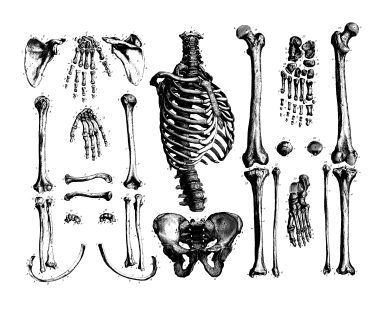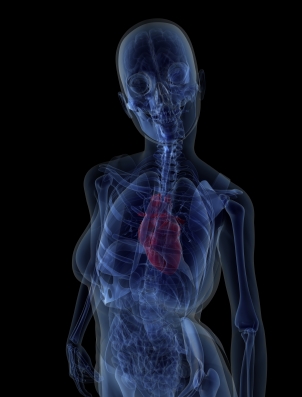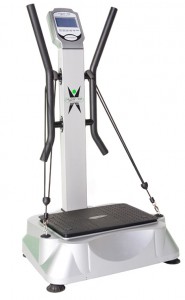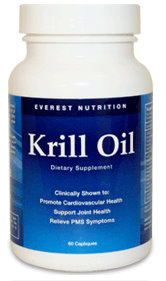Capture the fracture
Sounds like a new reality show for the over 50 set right? But it’s pretty serious.
A new report from the International Osteoporosis Foundation (IOF) demonstrates that one in two women over the age of 50 are at risk for fragility fractures that may be related to bone loss and not only trauma. In other words, broken hip bones, or bones in the wrist, arm or their vertebrae — usually resulting from a fall — may be a signal that something else is also at play. Moreover, the IOF reports that approximately 80% of both men and women who are treated at clinics or hospitals falling a fracture are not receiving screening for osteoporosis, osteopenia (low bone mineral density) and associated risk for future fractures.
So, why does this matter?
Well, according to IOF statistics, half of people who ultimately end up with a fractured hip in old age had a fragility fracture when they were younger. Moreover, 1/6th of menopausal women have had some sort of fragility fracture in their lives. Considering that women in particular lose up to 50% of their spongy, or trabecular bone (the network that makes up most of bone structure) and up to 30% of their cortical bone (the outer shell) within the first 10 years of the onset of menopause, and the body is creating a perfect storm. According to the IOF, up to a quarter of hip fractures can be prevented by early diagnosis and appropriate osteoporosis testing and follow up treatment.
Mind you, the treatments for osteoporosis are controversial. As I’ve written previously, the most popular drugs for osteoporosis — bisphosphonates — may be risky after about 5 years of use and even increase fracture risk in some women. However, there are important non-pharmacologic steps that can be taken to counterbalance risk, such as:
- Weight bearing exercise
- Insuring that you don’t sit too long at any given time while at work (women who sit for more than 9 hours a day have a 50% increased risk of hip fracture)
- Strengthening back muscles, which can help prevent vertebral fractures
- Insuring that adequate amounts of low-fat dairy, tofu and certain green vegetables are included in your daily diet. Note that some plant foods contain substances that can lower amounts of available calcium to the body, e.g. oxylates in spinach and rhubarb or phytates in dried beans, so you want to be sure to counter that with vegetables like broccoli, kale and bok choy, which are low in these substances.
Even if you eat a proper diet and exercise daily, you are still at risk of bone loss and fracture – it’s a natural result of aging and waning estrogen. However, if you are fifty or older and suffer a fracture, heck even if you are slightly younger, request a screening for bone loss and osteoporosis. The IOF says that most clinicians don’t follow this path — possibly due to cost concerns, time or even where the responsibility for care even lies. The latter is particularly important and is much like the ‘Bermuda Triangle,” where experts say that patients can disappear into a maze of “orthopedists, primary care physicians and osteoporosis experts” only never to be seen again (until they break a hip).
As always, information is power and the first point of care is truly you. Want to stay standing well into old age? Capture the fracture now.
Read MoreHeart disease and bone health. Is there a link?
It’s crazy, right? Not only do we have to worry about an increased risk of developing heart disease and osteoporosis and related fractures as we age, but it now appears that the two may be linked. In fact, in a study that will be published early next year in the journal Bone, researcher have found that an increased risk of fracture risk is associated with an increased risk of heart and related illnesses.
The findings, which are based on scientifically verified fracture and cardiovascular measures, show that among more than 300 healthy perimenopausal and post menopausal women who had the greatest likelihood for developing heart disease were 5.4 tines more likely to have a higher risk of a major fracture due to osteoporosis and bone loss, and 3 times more likely to have a higher hip fracture risk than women in the lower heart disease risk categories. This likelihood remained even after adjusting for factors such as years since beginning menopause, BMI, smoking and alcohol use, history of HRT use and level of physical activity.
The researchers acknowledge that although aging has been associated with both of these diseases, the link between the two cannot be explained by age alone.Indeed, other studies have shown that women with high cholesterol levels and other blood fat issues have lower bone mineral density measure. While more work needs to be done, the implication is clear: some of the many issues we potentially face as we age may be linked, especially among women. The message is pretty clear as well: take care of your bones and your heart benefits and visa versa.
Read MorePositive vibration, whole body vibration
I have been intrigued by whole body vibration (WBV) for a few years now. If you’ve caught earlier posts, you’ll recall that whole body vibration was developed in India and then passed onto the Greeks to improve overall functioning. More recently, it was used by the Russians to rehabilitate astronauts who may have lost muscle and bone mass during space missions. Now, however, it’s embraced by many sports medicine clinics and fitness facilities and gaining widespread popularity as strategy for improving leg muscle strength (and by default, balance and mobility) among adults as they age.
Positive evidence continues to accumulate in favour of WBV and in fact, researchers have conducted an extensive review of existing studies to assess whether or not WBV training can decrease the risk of falls and fractures. This is important since women as young as 35 years start to lose bone density and strength and by the time they reach the age of 50, they have a 40% risk of suffering a fracture due to osteoporosis during the rest of their lifetime. Moreover, during the first five years after menopause, women can experience as much as a 30% loss of bone density.
A bit of detail….this specific analysis included 15 studies enrolling both men and women between the ages of 64 and 82. Half of them included women only. WBV was conducted between 1 and 5 times per week over a period of 6 weeks to 18 months, and vibration was delivered during the sessions from anywhere to 15 seconds to 3 min for up to 27 times. The techniques were either vertical vibration (in which one stands on the platform and the vibration is delivered upwards), or side-alternating (in which the vibration is delivered side to side; this strategy apparently mimics a see-saw and the natural human gait.
Overall, they found that WBV may help to improve basic balance ability (i.e. sitting and standing balance) and offer significant benefit in terms of overall functional ability, especially in frailer individuals. Less clear, however, is whether or not it is effective in ultimately preventing falls; in this case, one could argue that by improving balance, WBV lowers fall and fracture risk but it isn’t so clear cut. What may actually be the case is that WBV plus an exercise program can help to do both.
So clearly, the verdict is still out on the usefulness of WBV. What’s more? The exact regimen that offers the most benefit remains unknown. Still, it’s clear that some data suggest that as we age, there are strategies other than drugs that might help to keep us walking and balanced.
As always, there is no time like the present to get moving on exercise and bone health awareness. You may be in your mid-30s and believe that nothing is going to change, but the stats are stacked against you without some sort of self-intervention.
Positive vibration? You bet!
Read More
Fish oil. One of these is not like the others…
[Photo credit: Australian Government Department of Sustainability, Environment, Water, Population and Communities. Australian Antarctic Division. ™2004.
Fish oils. Love em or hate em, they’re here to stay. And researchers will continue to research the hell out of these substances — namely omega 3 fatty acids — until they solve the question of ‘do they or don’t they?’ Meanwhile, true confession: as much as I’ve attempted to take fish oil supplements or flaxseed oil per health practitioner recommendations, I’ve always failed horribly. It’s the burp factor. They make me burp and I taste fish all day long. Can’t stand it. Or Stomach it. Or something.
And then I was contacted by the folks over at Everest Nutrition Corporation about its krill oil supplement. And I’ve been reborn.
Let me give you a brief overview of omega-3s and then the lowdown on krill. And why I’ve been converted.
Early last year I wrote a post on research that examined if some of the most commonly used ingredients in supplements may or may boost certain components of mental energy. Here’s an excerpt (although if you’d like to read the post in its entirety, you can find it here):
Omega-3 fatty acids I love fish oils. Researchers continue to study them because their utility is so broad, although the source of omega-3, dosage and ratio of EPA and DHA appear to be important factors in terms of mood (i.e. depression in particular) and mental energy. Overuse of fish oils can also impair the ability of blood to clot and depress overall immune functioning. Still, out of the dietary components that researchers studied, omega-3′s were by far the one most backed by clear data. Most recently, they’ve also been shown to help prevent stroke. In so far as mental energy goes, the researchers note that evidence suggests that fish oils may help delay or reduce cognitive decline in the elderly or improve verbal fluency. Less clear is whether this benefit is stronger if the they are taken earlier in life before cognitive decline. And of course, there is litte agreement on whether or not fish oils supplements convey the same benefits as obtaining the through dietary sources. And, if you choose to obtain your omega-3s through supplementation or pure oil, there is the issue of overfishing of the world’s oceans and how fish oil preparations may contribute to the problem.
So what about fish oil supplements derived from krill?
Krill are small, shrimp-like crustracean that feed on microscopic organisms in the ocean called phytoplankton. Compared to other sources of omega-3s, krill is in less danger of being overfished, one reason why it is so attractive. However, the omega 3s in krill oil attach themselves to fats the form cell membranes (phospholipids), rather than triglycerides, which theoretically makes krill derived omega-3 fatty acids more effective reducing fats in the heart and liver. Another benefit of krill oil is that it contains an antixidant called astaxanthin, which helps protect the body from damage by UV rays, and can help reduce LDL-cholesterol levels while raising HDL-cholesterol levels. Moreover, astaxanthin crosses the blood brain barrier, meaning that it might be of use in protecting eyes, the brain and the central nervous system from circulating free radicals.
However, buyer beware! Not all krill oils are created equal and you want to be certain that what you’re buying meets the highest standards in terms of:
- Meeting content claims about levels of ecosapentaenoic acid (EPA), doxosahexaenoic acid (DHA) and phospholipids
- Meeting claims about how much astaxanthin is delivered per capsule
- If the formulation meets standards for purity, safety and cleanliness per International Krill Oil Standards (IKOS)
- If the product is stable
- If the product meets the standards for contents of heavy metals and mercury
You also need to know that krill oil should not be taken by people with shellfish allergies. Additionally, some people report having gastrointestinal issues, e.g. diarrhea, loose stools when taking krill oil; this is due to the fatty acid that is present in the oil, and may be alleviated by taking a lower dose. Like other forms of fish oil, krill oil may also thin the blood and impair its ability to clot, and in some cases, may interact with thyroid medication. Pregnant women should speak to their doctors before trying krill oil.
Like many other forms of omega-3 fatty acids, krill oil can be expensive. A 30-day supply of Everest Nutrition’s Krill Oil costs roughly $30 a month, which comes out to $1 a day or $.50 a capsule.
So, what do I think? I’m a believer. I have had physicians and other healthcare practitioners recommend that I take fish oil for as long as I can remember. And I haven’t because of the burp factor. I’m grateful to have discovered krill oil. And I highly recommend Everest Nutrition’s formulation, primarily because the manufacturer adheres to the highest of standards.
[Disclaimer: I was not paid to write this review of Everest Nutrition Krill Oil. However, company representatives did provide me with product to try.]
Read More
Newsflash…Before you ‘D’ know the facts. New recommendations from EMAS.
Vitamin D. Lately it’s been touted as the cure-all for all that ails. From bone health and diabetes, to cancer and infections, vitamin D is the go-to supplement. But, do you really need it? And how much should you be taking on a daily basis?
Vitamin D levels are reportedly low in women undergoing menopause and because it is necessary to maintain bone health, there is no question that it’s in great demand by our bodies. This is especially true of fair skinned individuals, women, and people who live at higher altitudes. In fact, research shows that a number of factors can influence how the body synthesizes or produces Vitamin D, including altitude, time of year (e.g. winter) time of day, amount of exposed skin at any given time, skin pigmentation, extensive use of sun protection (i.e. sunscreen, protective clothing, shade) and air pollution). However, the more news that comes out about vitamin D, the more confusion abounds as to its true benefits and how much you should be taking.
Some of that much needed detail is provided in a recent statement issued by the European Menopause and Andropause Society. Rather that put you to sleep with all the details, here a few highlights that sets current knowledge about vitamin D on the correct path:
- Although there have been a ton of studies on vitamin D, linking it to outcomes and risks and benefits in a variety of conditions, evidence for its benefit is strongest in terms of bone/skeletal health.
- Osteoporosis is very common in postmenopausal women leading to increased fracture risk. It appears that adequate levels of vitamin D may help preserve bone structure and contribute to the function of muscles. In studies, women with the lowest vitamin D blood levels were shown to have the highest fracture risk.
- Healthy postmenopausal women can insure that their body’s levels of vitamin D are optimized by exposing skin to the sun, 15 minutes at a time at least three to four times a week during Spring, Summer and Fall. This does not include artificial UV exposure from tanning booths.
- Experts recommend that women supplement sun exposure with no more than 800 to 1,000 IU of vitamin D supplements a day.
- If you are someone at risk for low vitamin D levels, you should see your doctor or health care practitioner for screening to achieve optimal vitamin D levels.
- Women who are obese, have conditions that prevent proper absorption of nutrients (for example, HIV or chronic diarrhea) or have liver or kidney issues need to have tailored vitamin D recommendations.
And the news about over supplementation and toxicity? First of all, you can never get vitamin D toxicity through sunlight (although as we know, too much sun can lead to other problems, like skin cancer). And, toxicity issues have been linked to dosages above 50,000 IU over several months time. Last, women with cancer are likely to convert vitamin D in the body faster, so need lower levels. Again, this calls for monitoring by a health practitioner.
Overall, before you ‘D.’ know the facts. These recommendations are a great start.
Read More
Plums…delicious, sweet. And, good for bone health?
[Image: all rights reserved 2012. Used with permission by Tartella. Visit them online at http://www.tartella.com/ and if you love this print as much as I do, you can purchase it in their Etsy store.]
Yowza! I am excited about study findings published in the British Journal of Nutrition linking dried plums (better known as the lowly prune) to improved bone mineral density in menopausal women. If these findings ring true and can be duplicated in larger groups of women, they may have a tremendous impact on the steps we take to preserve our bones as we age — most notably, the ability to avoid bisphosphonates — which have been linked to collapse of jaw bones and even an increase in the fractures they are supposed to protect. Moreover, although calcium supplementation is broadly recommended, there is an indication that it may increase heart disease risk in some women.
However, as one of the investigators note in BJN, study findings consistently show that greater intakes of fruits and vegetables have positive effects on bone resorption (the breakdown of bone), adding prunes among fruits and onions among vegetables, to be the most effective functional foods in terms of their actions on modulating the process by which bones break down and build up again.
In animal studies, prunes were shown to prevent bone loss as well as restore bone mineral density in conditions created to mimic bone loss associated with osteoporosis. In addition to these studies, researchers had also a conducted a short, three-month study in menopausal women in whom bone mass was improved simply by eating around 10 prunes (100 g) daily.
In this latest iteration, the same researchers compared two groups of menopausal women assigned to eat around 100 gm of prunes (~10) or 75 gm dried apples (the equivalent of the prunes in terms of energy, carbohydrates, fats and fiber) daily for a year. All of the women had been in menopause for anywhere from one to 10 years, were not on hormone therapy and were also asked to take 500 mg calcium plus 400 IU vitamin D with their daily dried fruit.
The findings? By the end of one year, women eating prunes had significantly lower levels of several markers for bone turnover compared to their peers who ate dried apple. Conversely, the prune eaters had significantly higher levels of bone mineral density in their ulnas (one of two long bones in the forearm) and spine compared to the other group. The researchers say that this is partly due to the fact that prunes suppress the rate at which bone cells break down bone, which exceeds the rate at which they build it up as we age.
Women in particular lose up to 50% of their spongy, or trabecular bone (the network that makes up most of bone structure) and up to 30% of their cortical bone (the outer shell) within the first 10 years of the onset of menopause. Of the investigators, Professor and chair of Florida State University’s Department of Nutrition, Bahram Arjmandi, suggests that women (and men) interested in maintaining or even improving bone health start eating two to three prunes a day and gradually build to six to 10. Arjmandi says to “do something meaningful and practical beforehand, ” and “don’t wait until you get a fracture or are diagnosed with osteoporosis” and need medication.
Sure, prunes get a bad rap. But aren’t ‘bad’ bones even worse? Truly, prunes can be ‘as delicious and sweet’ as plums. The writing on the wall suggests that you don’t wait until it’s too late.
Read More













